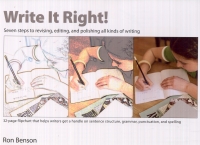| ________________
CM . . . . Volume XVII Number 39. . . .June 10, 2011. 
 |
Write It Right! Seven Steps to Revising, Editing, and Polishing All Kinds of Writing.
Ron Benson.
Markham, ON: Pembroke, 2011.
32 pp., stapled, $12.95.
ISBN 978-1-55138-262-3.
Subject Headings:
English language-Rhetoric-Handbooks, manuals, etc.
English language-Grammar-Handbooks, manuals, etc.
Professional: Teacher Resource: Grades 4-8; Student Resource: Grades 7-10.
Review by Betty Klassen.
**/4
|
| |
|

excerpt:
We know we begin writing by just “Writing It.” If we’re going to share our writing, we end with sharing. But in between the stages can blur. Some write, and then revise, edit, and present. Others pay attention to the spelling, grammar, and sentence structure while they are writing. Some write only a sentence or two before they begin revising; others write the entire composition. All that’s certain is that all writers have to do things that make writing better: revising, editing, polishing, sharing. The order of those actions may vary from writer to writer and from writing to writing.
Writing It Right! is a collection of tips, aids, checklists, explanations, and examples that you can refer to as you work through the various stages of your writing, particularly the revision and editing stages.
This 32 page flipchart booklet is written to students as an instruction booklet or “a companion to guide you” to assist them in becoming better writers, and as such it focuses on the basics of writing: grammar, sentence structure, spelling and punctuation. It could be used as a
companion book to other Pembroke flip books, 12 Sides to Your Story (Foster, G., 2009) and The Poetry Experience (Fitch, S. & Swartz, L., 2008).
One of the strengths of this booklet is that it is well-organized and uses an attractive format with color blocking and bulleted points to focus the reader/writer. It has both a detailed Table of Contents and an Index to assist students or teachers in finding the area of writing they wish to look-up. Checklists for revision, clarity, sentence “sense” and punctuation are embedded in the text. The booklet also includes three reproducible pages to provide students a method of tracking the forms of writing they are using, a grammar/usage and a punctuation checklist.
After two pages of introduction and instruction, Benson gets to the heart of the writing process, providing readers with a number of ideas for choosing a topic, a purpose and a form for their writing. This is followed by steps for revision and suggestions for “hearing” what you’ve written. Students are encouraged to collaborate on the revision process by reading their writing to someone and inviting a response, or to “ask someone to read your writing to you.”
Eight ways to share or publish student writing are provided bringing the writing process section to a close.
The majority of the booklet – two-thirds – supplies writers with the rules of writing, explaining the basic parts of speech: nouns, pronouns, verbs, adjectives and adverbs. Writing styles are mentioned while sentence styles and sentence problems are elaborated on with helpful examples. Spelling tips encourage students to pronounce words correctly, keep lists of new words, create a personal spelling list and use resources – your teacher, a friend, spellcheck and an online dictionary. The page on frequently confused words and contractions (there, their, and they’re) succinctly provides helpful examples for student writers. Four pages on punctuation cover the basics from commas to quotation marks, and include suggestions for proofreading.
The final page is addressed to teachers, encouraging them to support student writers by giving them time, mini-lessons, a few examples, conferences, and opportunities for authenticity, self and peer assessment, and sharing.
While the length of this booklet does not allow for a lot of detail, a few changes in format could address a few shortcomings. A page of “More Words That Give Writers Trouble!”is not sufficient to help students choose the correct word. To be useful, the words require some explanation as listing desert/dessert or principal/principle is not enough information. It is ironic that a usage error of then/than (p. 24) was not corrected when booklet was edited.
Another concern is that not all of this booklet would be helpful to English Language Learners. The statement suggesting students choose the pronoun that “sounds right,” and the ten “Fumblerules” of grammar inset which identifies common errors by mis-examples would not assist these students who are an increasing presence in Canadian classrooms.
There is no mention of attending to paragraphing. Letter writing formats are only mentioned to identify the correct punctuation for a friendly or business letter salutation. Adding some recommended websites could add these details without taking up much space.
On pages 14 and 15, the format suddenly changes, requiring the reader to read down page 14 and 15 and then up to the top of page 14. On page 16, the format returns to the original format of reading both columns on one page before moving on to the next one. This might confuse some students.
Benson has brought 30 years of experience as an educator to the challenge of taking a vast subject and confining it to 32 short pages. His experience ranges from a K-8 classroom teacher, to a university instructor, and includes various administration roles.
Recommended with reservations.
Betty Klassen teaches in the Middle Years Program in the Faculty of Education at the University of Manitoba.

To comment on this title or this review, send mail to
cm@umanitoba.ca.
Copyright © the Manitoba Library Association. Reproduction for personal use is permitted only if this copyright notice is maintained. Any other reproduction is prohibited without permission.
NEXT REVIEW |
TABLE OF CONTENTS FOR THIS ISSUE- June 10, 2011.
AUTHORS |
TITLES |
MEDIA REVIEWS |
PROFILES |
BACK ISSUES |
SEARCH |
CMARCHIVE |
HOME |
